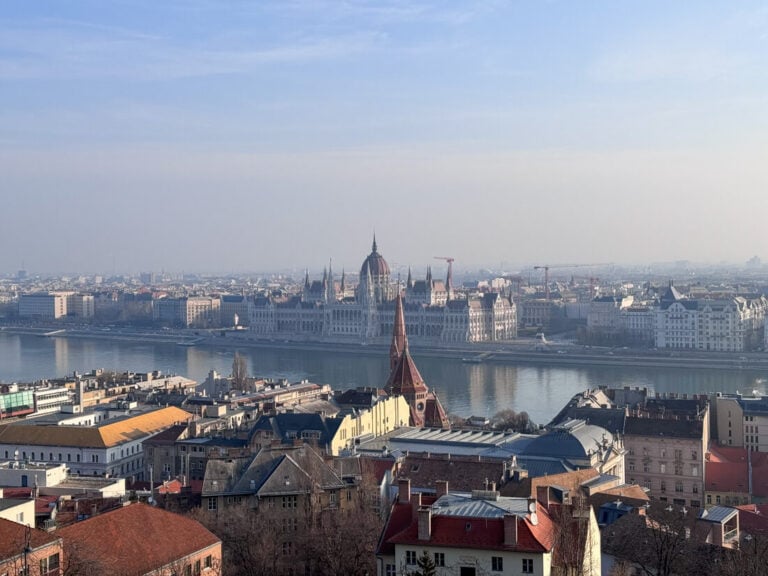The Ultimate Budapest Travel Guide: All You Need to Know

Found on the banks of the Danube River, the beautiful city of Budapest is a popular city destination in Eastern Europe.
Known for its grand architecture, vibrant cultural scene, tasty food and interesting history, Hungary’s capital offers everything you could want from a European city break.
I spent over a week exploring Budapest, and I absolutely loved it. I spent my days wandering the historic streets and admiring the impressive architecture and stunning views. It really is a wonderful city and one of my favourites in Europe.
In this Budapest travel guide, I’ve answered all your questions about visiting the Hungarian capital. This includes how long to stay in Budapest, when to visit the city, how to get around, and much more.
A little bit about Budapest
Budapest, the capital city of Hungary, has a long and interesting history. (I know no one is reading this post for a history lesson, but bear with me).
The city’s history dates all the way back to the Romans in the 1st century. However, Budapest wasn’t always a single city.
Previously, there were three cities occupying the area: Buda, Pest and Óbuda. The three cities were unified in 1872, creating modern Budapest. The late 19th century saw significant urban development, with iconic landmarks like the Chain Bridge and the Parliament Building built.

Sadly, much of the city was destroyed during World War II and the Soviet occupation during the Cold War. Yet, the city has always rebuilt and remained resilient.
Most of your trip to Budapest will take place in two main areas: Buda and Pest. Pest is the vibrant, central part of the city, where you’ll find landmarks like the Hungarian Parliament Building and trendy restaurants. On the other side of the Danube, you’ll find Buda, which is rich in history and home to impressive buildings like Fisherman’s Bastion.
How long to spend in Budapest?
Plan to spend at least two days in Budapest. This should give you time to see all the main highlights without skipping anything major, especially if you have an extra morning or afternoon.
However, I would say three days is the ideal amount of time to spend in Budapest. This will allow you to explore at a slightly slower pace and visit lesser-known attractions.
If you have more than three days, consider a day trip to somewhere such as Visegrad or Szentendre.

When is the best time of year to visit Hungary
Hungary is a year-round destination, and the Hungarian capital can be visited at any time of year.
As with most of Europe, each season has its benefits and drawbacks.
Winter
The winter months are a great option for a trip to Budapest. There are fewer crowds, and a December trip means you can visit the many Christmas markets. However, the winter months can be very cold, and there’s also a possibility of heavy snow.
Spring/Autumn
Spring and autumn are excellent times to visit Budapest. The weather is warmer and often sunny, and there are fewer tourists than in summer.
Summer
Summer is the peak season in Budapest and Hungary as a whole. It’s a great time to visit the city to experience one of its many cultural festivals, but be prepared for crowds and higher prices.
I visited Budapest in February and had perfect weather. It was very cold, but most days had clear blue skies! While there were some queues for popular attractions and restaurants, it didn’t feel overcrowded.
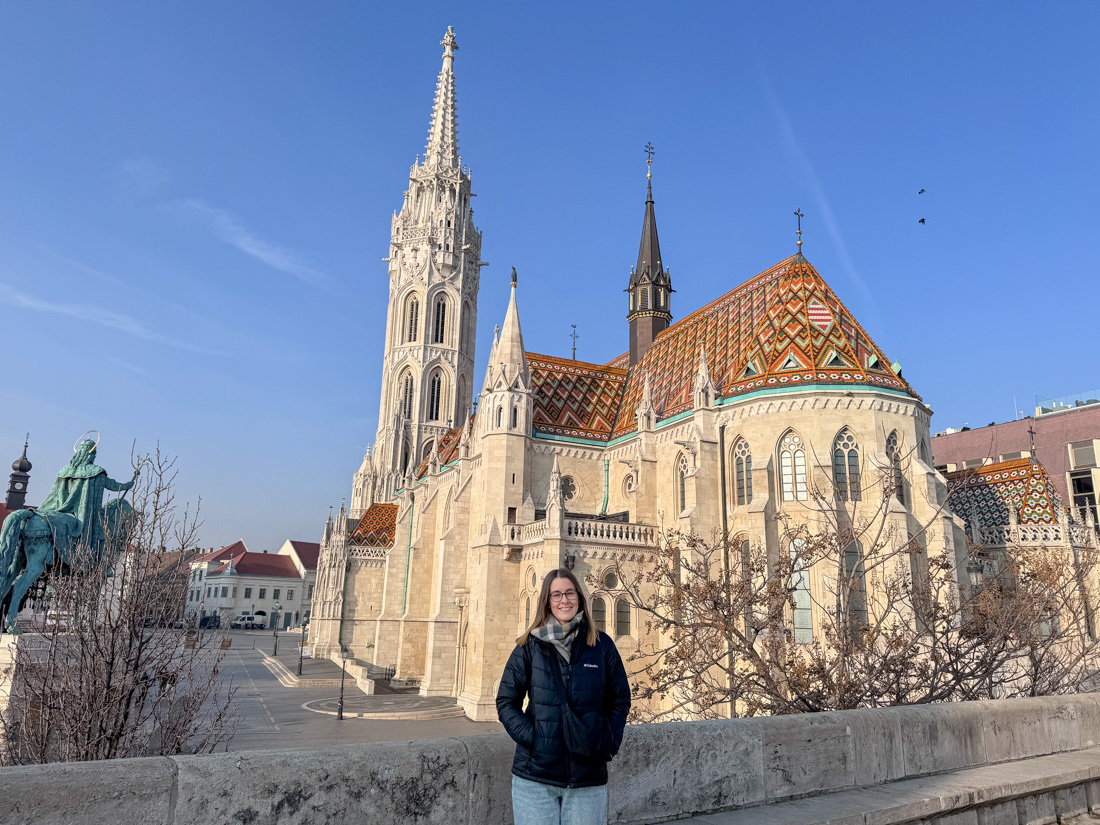
How to get from Budapest airport to the city
Use the bus
The best way to get from Budapest Airport to the city is to use the 100E airport express bus. The bus stop is right outside the terminal, and it runs 24 hours a day, seven days a week!
The journey from the airport to the city centre takes about 40 minutes, and there are three different stops in the city centre:
- Kalvin Square (Kálvin Tér)
- Astoria M
- Deak Ferenc Ter (Deák Ferenc Tér)
All of the stops are well-located, and most central hotels are within a 15-20 minute walk away.
As of 2025, the cost of the express bus is 2200 Huf (about $6 / €5.50). There are ticket machines right outside the airport terminal, or you can pay on the machine as you enter the bus. There is usually staff to help you.
The bus runs every 7 to 9 minutes during the day and every 30 to 40 minutes at night.
It’s also possible to use the 200E bus to get between the airport and the city. The bus runs between Budapest Airport and Kőbánya-Kispest station. You can take the Metro or bus from here to the city. It’s a cheaper option but takes a lot longer.
Book a transfer
If you’d prefer to skip public transport, you can book a shuttle with MiniBud. It’s a fast and convenient way to get between the airport and the city and offers door-to-door service.
If you plan to buy a Budapest Card, you can even choose an option to include the transfer.
Take a taxi or Uber
There’s a taxi rank right outside the terminal exit. You can also book an Uber.

Where to stay in Budapest
Choosing where to stay in a new city can sometimes be tricky. While it’s ideal to be centrally located, it’s also nice to get a taste of local life and be away from the chaos of the city centre.
Luckily, choosing where to stay in Budapest is relatively straightforward. The city comprises of 23 Districts, and Districts 1, 5, 6 & 7 are all well-located and perfect for visitors.
My personal favourite area to stay in is District VII – Erzsébetváros or Elizabethtown. It’s home to Budapest’s famous Jewish Quarter, and it’s filled with unique restaurants and fun bars. There’s also plenty of luxury hotels and budget accommodation to choose from.
What to do in Budapest
Below, you’ll find a quick overview of unmissable things to do in Budapest. For a more detailed breakdown, check out how to spend the perfect two days in Budapest.
- Explore Buda (Home to Buda Castle, Fisherman’s Bastion and Matthias Church)
- Join a walking tour (I suggest either joining a free walking tour, or doing a self-guided tour of the centre. Must-visit stops include: Hungarian Parliament Building; Shoes on the Danube Bank; Great Market Hall; Széchenyi Chain Bridge)
- Exploring St Stephen’s Basilica, the largest church in Budapest
- Wandering around the Jewish Quarter (home to landmarks such as the Dohány Street Synagogue, the largest synagogue in Europe)
- Relax in thermal baths (Széchenyi Thermal Bath is one of the most famous)
- Visit a museum
- Walk around City Park
Check back soon for a more detailed guide on things to do in Budapest.

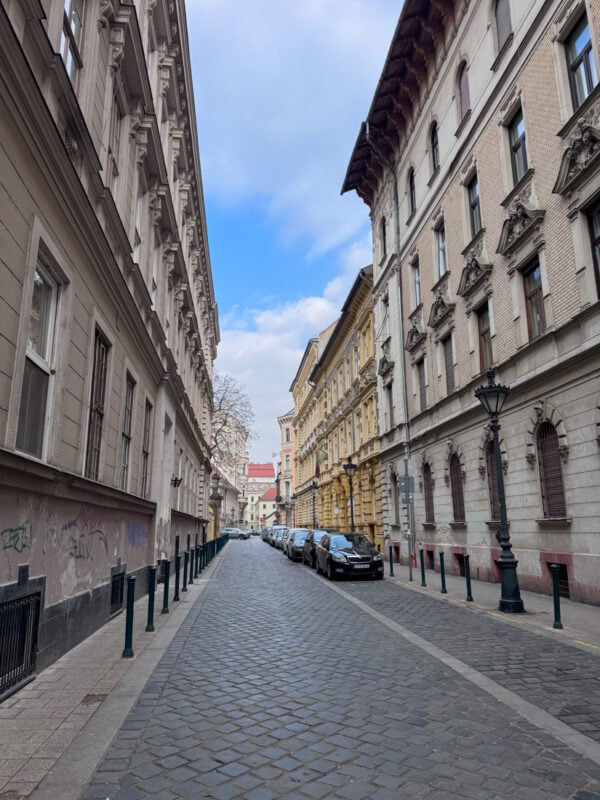
Day Trips from Budapest
If you have more than a couple of days in Budapest, you might want to consider a day trip to a nearby destination. Most people consider Budapest to be the only place in Hungary worth exploring, but this couldn’t be further from the truth.
Here are a few of the best day trips from Budapest (no car required).
Visegrád
Just an hour on a train out of Budapest, Visegrad is the perfect day trip. It’s famous for its medieval castle perched on a hill, offering stunning views over the Danube Bend. You can explore the castle ruins (just be prepared for a bit of a hike) or visit the Visegrad Royal Palace.
If you do visit Visegrád, I recommend tagging on Esztergom. It’s another 45-minutes on the bus, but it’s a lovely town and you can cross the bridge into Slovakia.
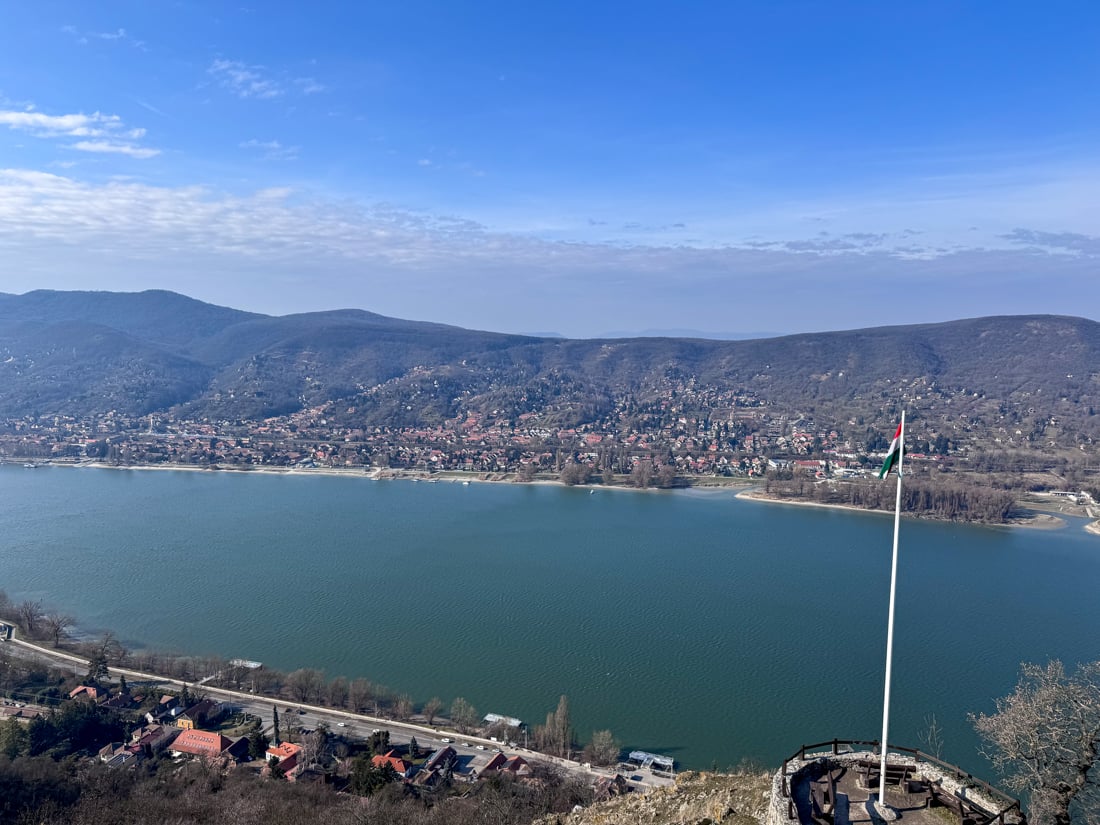
Szentendre
Located just 12 miles (20 km) north of Budapest, Szentendre is a picturesque town known for its colourful architecture, cobblestone streets, and art galleries. It sits on the banks of the Danube River and is perfect for a relaxing day of wandering, visiting museums, and enjoying local cafes.
I visited here in the winter when much of the town was closed, but it was still worth it for the beautiful views and insight into local life.
👉 Book a day tour to Szentendre from Budapest
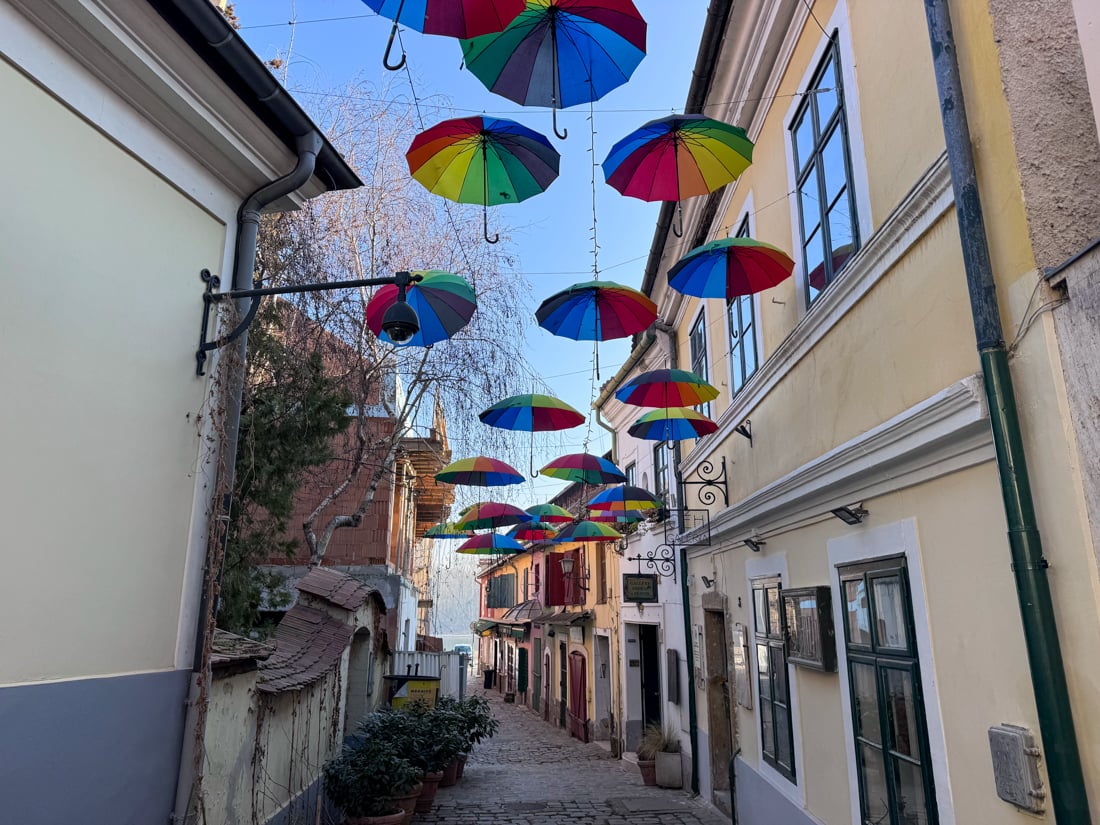
Lake Balaton
Lake Balaton is Central Europe’s largest freshwater lake and a fantastic summer destination for both tourists and locals. Popular towns on the lake include Balatonfüred and Tihany. It’s quite a trek from Budapest, so I’d advise spending a night or two there if you can. It’s a beautiful destination!
👉 Consider this full day tour to take the hassle out of planning.
János Hill
Technically still in Budapest (but worthy of a day trip), János Hill is the highest point in Budapest. It offers stunning panoramic views of the city and surrounding landscapes. You can access the Elizabeth Lookout via the Libegő cable car and get 360-degree views of Budapest. There are also many hiking trails through forests in the area.
Eger
Known for its wine and history, Eger is a beautiful town about two hours from Budapest. Visit the famous Egri Castle, enjoy a wine-tasting session in the Valley of the Beautiful Women (Szépasszonyvölgy), or explore the charming historic center.
As Eger is quite far from Budapest, you might joining a tour is a better option.
Other day trip options include Pécs, Vienna and even Bratislava, but they’re all quite far away (and I’m not personally sure it’s worthwhile for the day).
How to get around Budapest
Budapest is a super simple city to navigate. It’s quite a compact city and for the most part, you’ll find attractions are all within walking distance.
If you do need to use public transport, you’ll be pleased to hear it’s affordable and straightforward to use.
Metro: Budapest has four metro lines (M1, M2, M3, M4) that cover most major areas.
Trams: Trams are an efficient way to get around. Tram 2 is especially scenic and offers great views of the Danube River.
Buses: Buses cover most areas not reached by the metro or trams. They’re a good option for more specific routes.
I used Google Maps to navigate the city. There’s also an app called Budapest Go which can help to plan your journey and book your ticket.
You can purchase transport tickets at most of the stations and stops. You’ll see purple machines which give you the option to buy individual tickets or travel passes. You can also purchase tickets on the buses themselves, but you’ll need the exact cash for this.
Don’t forget to validate your ticket. If you’ve bought an individual ticket, it’s essential to validate the ticket. At the Metro stations, and on trams and buses, you’ll see small yellow or orange boxes. You need to put the ticket inside of this device and pull the lever forward. If you have an electronic ticket or travel pass, there will be a QR code to scan.
If you don’t validate your ticket, you could face a hefty fine.
Budapest also offers travel passes which offer unlimited travel within the city for a set number of days. I bought the 72-hour hour one, but I didn’t use it enough to warrant the price. I would work out how much you think you’ll need to use public transport, then you can decide if it’s worth the price (the travel cards do not include the 100E airport express bus).
Pro tip: If you’re spending more than three days in Budapest, consider the 15-day pass. It’s not much more expensive than the 3-day one, and well worth it for longer stays.
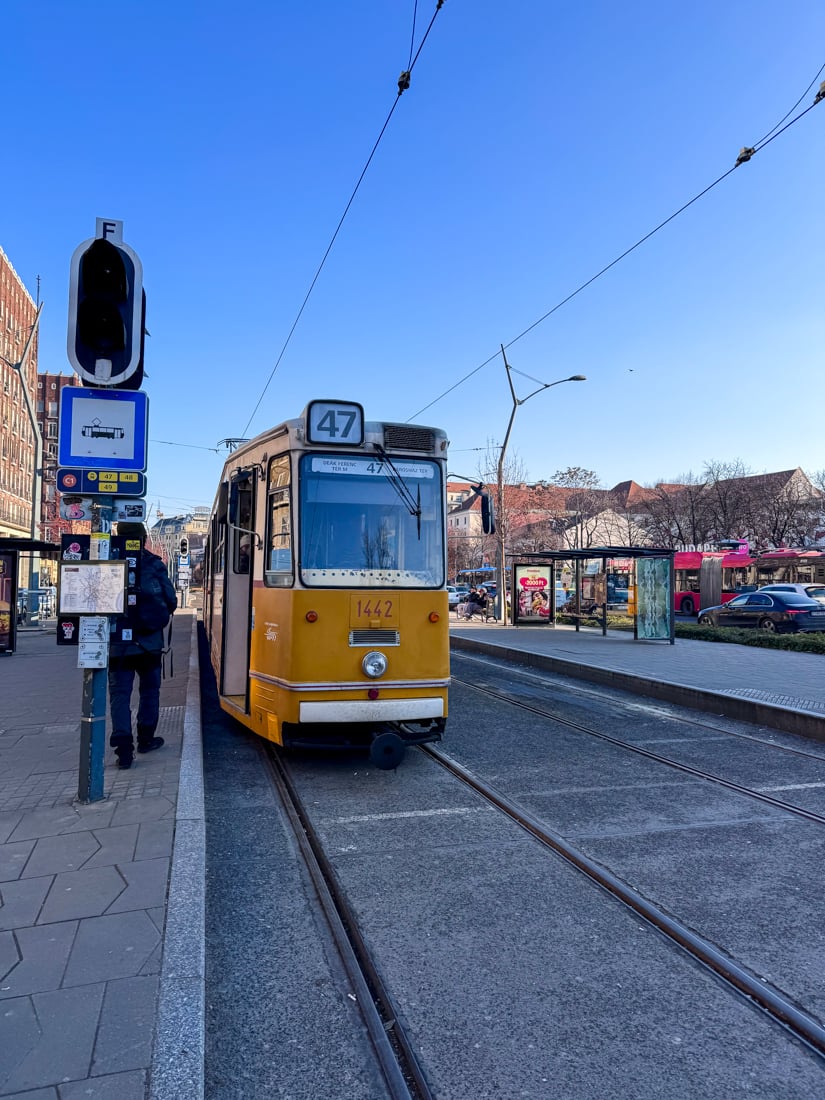

Is a Budapest card worth it?
As with most major European cities, there’s the option to buy a city pass which gives you access to various attractions and public transport.
In Budapest, it’s known as the Budapest Card. It includes entry to popular attractions, including various thermal baths, the Hungarian National Museum, the Hungarian National Gallery, a Danube River Cruise and entry to St. Stephen’s Basilica (double check the website for the latest inclusions).
There are different types of card to buy. All include the attractions, one also includes unlimited public transport, and one includes a hop-on, hop-off bus. You can purchase cards ranging from 24 hours to 120 hours in length.
So, is it worth it? It’s hard to say! If you’re planning to visit lots of attractions and use public transport, then yes, the card might be beneficial for you.
It can be great value, but it’s only really worthwhile if you want to visit several of the attractions. I would add up the entry fees and see how much it comes to. You can then compare the total cost with the cost of the card.
If you have two days in Budapest and want to see the top attractions, it might very much be worthwhile.
I opted against it as I was in Budapest for a week and didn’t want to pay for the full 7-day card, or rush around trying to see everything in a single day.

Is Budapest safe?
Yes! Budapest is generally considered a very safe city. I spent a few days travelling solo in Budapest before meeting my friend, and I felt completely safe walking around the city.
Of course, crimes can happen, so it’s essential to follow a few simple rules.
The most common crime against tourists in Budapest is petty theft, such as phone snatching and pick-pocketing. Having said that, it tends to be less common than in other cities such as London or Rome.
Even so, try not to flaunt your belongings. Keep your phone away unless essential, and keep your wallet somewhere inaccessible to others (I love using a crossbody bag).
For my fellow solo female travellers, I felt safe walking around Budapest, including in the dark. However, I always stuck to busy tourist areas with well-lit streets.
Paying for things in Budapest
Until very recently, it was advised always to carry cash in Budapest. However, I found that I could pay for almost everything on my credit card. In fact, most businesses seemed to prefer card payments.
The only time I needed cash was when shopping at a market, such as the Grand Central Market. I also needed cash when visiting Visegrad Castle from Budapest.
Otherwise, everywhere I visited accepted card payments.
I recommend carrying a small amount of cash just in case you want to buy something from a market or small business. But for the most part, you’ll have no issue using a card.
Withdrawing cash in Budapest is also very easy. There are ATMs all around the city, and most of them have free withdrawals (depending on your credit card provider).
Remember to choose a card that allows you to use it abroad for free. For those in the UK and Europe, I recommend Starling, Revolut, or Wise.
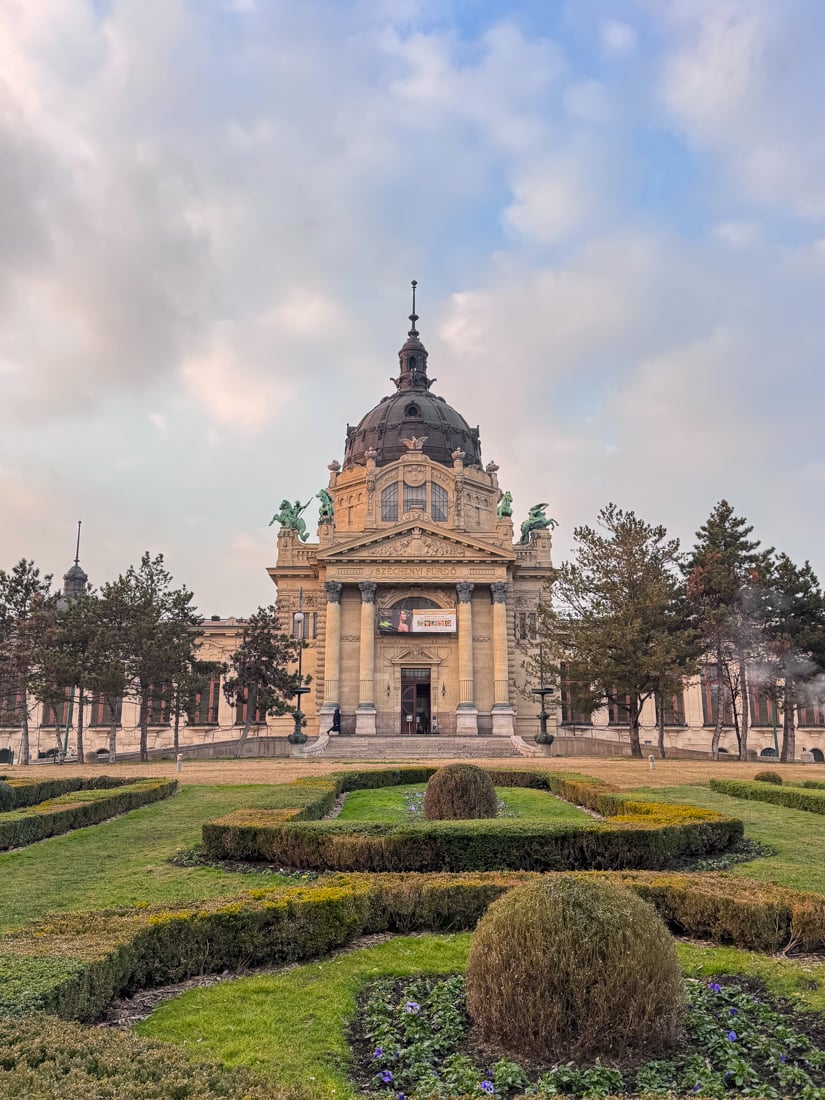
Where to eat in Budapest
Budapest is a haven for foodies. The city is filled to the brim with tasty restaurants, quality bakeries and local Hungarian restaurants.
Honestly, I could have spent another month in Budapest trying everything I wanted to eat.
For those keen to try some more local foods, here are a few unique Hungarian foods to try:
- Langos: This is Hungary’s answer to a pizza. It’s deep-fried dough traditionally served with sour cream, cheese and other toppings.
- Nokedli: Dumplings are one of my favourite foods, and I love trying all the different versions around the world. Hungary’s are slightly different in that they’re more like dough or even gnocchi.
- Gulyás (Goulash): Goulash is the national dish of Hungary. It’s a hearty and flavourful stew that’s typically made with beef, onions, paprika, and other vegetables.
- Töltött Káposzta (Stuffed Cabbage): This dish consists of cabbage leaves stuffed with ground pork, rice, and seasonings. It’s often served with sour cream.
- Dobos Torte: For dessert, try the famous Dobos Torte. This layered sponge cake with chocolate buttercream and a caramel topping is one of Hungary’s most beloved desserts.
Vegan and vegetarian restaurants in Budapest
Hungarian cuisine is meat-focused, so I was slightly nervous about finding vegan and vegetarian restaurants in Budapest (I’m vegetarian, but I try to eat vegan where I can). However, I had no reason to be concerned.
Budapest is by far one of the most vegan-friendly cities I have ever been to. The supermarkets have many options, including a range of plant-based milks, vegan cheeses and many meat alternatives.
Every coffee shop I tried had a variety of plant-based milk, and all the restaurants I went to had tasty vegan options.
Here are a few of my favourite cafes and restaurants in Budapest with vegan friendly options.
- Vegan Garden: This was one of my favourite meals in Budapest. The menu is entirely vegan, and they serve a range of classic Hungarian dishes, as well as pizzas, burgers and other favourites. My friend and I shared a burger and pizza, they were so, so good.
- Tahina Bites: Best. Falafel. Ever. If I could eat this every day, I would. The small cafe is entirely vegan, and you can build your own falafel wrap or bowl. Honestly, it was SOOO good. I’m still dreaming about it.
- 4Minutes Cafe: Close to Fisherman’s Bastion, this is an entirely vegan cafe. They serve a few delicious snacks, as well as quality coffee.
- Vega City: Right in the city’s centre, this is an excellent vegan lunch stop. They change the menu each week and offer a range of hot and cold options.
- Ichigo: This is a tasty option for those craving sushi. While they also serve meat & fish, they have a range of vegan options, such as vegan nuggets and tofu sushi rolls.
- Napfényes Restaurant & Confectionery: If you want to try traditional Hungarian food, I highly recommend Napfényes. The menu is filled with vegan versions of tasty local favourites. They also have a selection of vegan cakes and pastries.
- Epoch Vegan Burger: Epoch is an excellent option for grabbing a quick and tasty vegan burger.
- Mazel Tov: Their mediterranean menu isn’t strictly vegan, but there’s a great range of vegan and veggie dishes to try. It’s an upscale restaurant and I’d advise making an reservation.
- Hu Lu Lu Vietnamese: Another non-vegan restaurant, but they have some great tofu-based dishes.
- Oriental Soup House: If you’re craving Asian soup, look no further than Oriental Food House. They have a seperate vegan menu with Tofu and a range of vegetable-based soups to try. It’s quick, cheap and delicious.
These are just a few of the spots I was able to try, but there are further suggestions on Happy Cow.


Other helpful tips for visiting Budapest
What to pack for Budapest | Budapest is a classic European city and quite frankly, anything goes! It can be very casual during the day, but there are lots of upscale places to visit in the evening. I took jeans and casual jumpers, plus a couple of nicer evening outfits. If you’re visiting in the winter, don’t forget some warm clothes and a coat.
Don’t forget swimwear | If you want to experience the traditional thermal baths, don’t forget to pack a swimsuit, towel and flip flops. They can be very expensive to rent.
Wear comfy shoes | You’ll likely be doing A LOT of walking in Budapest. I hit 30,000 steps on one of my days in the city. Be sure to wear comfortable shoes.
Consider booking ahead | I visited in the off-season (February), but still found a few activities had sold out while I was there. This includes the Prosecco River Cruise and entry to the Hungarian Parliament Building.
Make reservations | If there’s somewhere you really want to eat, consider making a reservation. I saw very long lines for popular restaurants. I also found that people enjoyed early breakfasts in Budapest. Even at 8 am on a Sunday, we struggled to get a table in a cafe.
Summary: Is Budapest worth visiting?
Oh, yes! Budapest is absolutely worth visiting. This beautiful city has become a popular European city break in recent years, and for very good reason.
If I’m being honest, Budapest wasn’t very high on my list of places to go. Truth be told, I’m much more of a nature/outdoors person, and I tend to get bored in cities after a day or two.
However, I fell in love with Budapest. Although it’s the capital of Hungary, it really didn’t feel too crowded or overwhelming.
The city’s unique architecture combined with views of the Danube River make it argably one of the most beautiful cities in Europe. With endless historic buildings, museums, world-class restaurants and hiking right on its doorstep, there really is something for everyone in Budapest.
I hope you found this Budapest travel guide useful. Share to Pinterest to save the information for later.




